
Busan,officially known as Busan Metropolitan City, is South Korea's second most populous city after Seoul,with a population of over 3.4 million inhabitants as of 2017. Formerly romanized as Pusan,it is the economic,cultural and educational center of southeastern South Korea,with its port being South Korea's busiest and the sixth-busiest in the world. The surrounding "Southeastern Maritime Industrial Region" is South Korea's largest industrial area. The large volumes of port traffic and urban population in excess of 1 million make Busan a Large-Port metropolis using the Southampton System of Port-City classification.

The Donghae Nambu Line is a railway line connecting Busan to Pohang in South Korea. The line runs along South Korea's east coast. On December 30,2016,it was merged into Donghae Line.
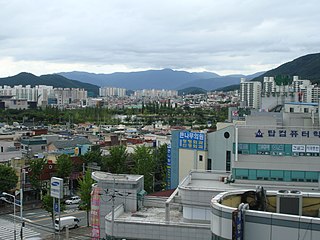
Gimhae is a city in South Gyeongsang Province,South Korea. It is the seat of the large Gimhae Kim clan,one of the largest Kim clans in Korea. The Gimhae Kims claim descent from the ancient royal house of Geumgwan Gaya,which was based in Gimhae. Gimhae is situated near the Nakdong River.

Busanjin Station is a railway station in Dong-gu,Busan,southeast South Korea. It is the terminus of the Donghae Line to Pohang,and a stop on the Gyeongbu Line to Seoul. Passenger service was eliminated in 2005,leaving cargo service only.
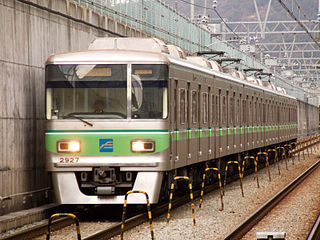
The Busan Metro is the urban rail system operated by the Busan Transportation Corporation of Busan,South Korea. The metro network first opened in 1985 with seventeen stations,making Busan the second city in South Korea and third in the Korean Peninsula to have a metro system. The Metro itself consists of 4 numbered lines,covering 116.5 kilometres (72.4 mi) of route and serving 114 stations. Including the BGL and the Donghae Line,the network covers 205.6 kilometres (127.8 mi) of route and serving 158 stations.
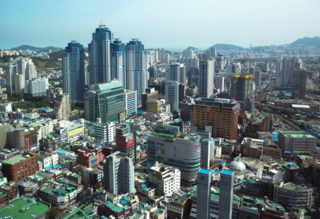
Busanjin District is a gu in central Busan,South Korea. It has an area of 29.7 km²,and a population of about 410,000. The name is sometimes abbreviated locally as "Jin-gu". Busanjin-gu is home to a major shopping,entertainment,and business area called Seomyeon.

Sasang station is a railway station of the Gyeongbu Line and Gaya Line of Korail located in Gwaebeop-dong,Sasang District,Busan. It is also served by Mugunghwa-ho trains on the Gyeongbu Line.

Dongducheon Jungang Station is a train station on the Seoul Subway Line 1 and the Gyeongwon Line. The name means Dongducheon Central Station. It was also once known as Eosu-dongStation.

The Busan–Gimhae Light Rail Transit is a light metro system between the cities of Busan and Gimhae in South Korea. The line has 21 stations including Daejeo and Sasang where passengers can transfer to Busan Metro Line 3 and Line 2 respectively. The line thus acts as a connecting rail between both Gimhae and Busan International Airport with two western outreaches of the Busan Metro system.
Deoksan station is a railway station in South Korea. It was on the Gyeongjeon Line. After double tracking,it became part of the Deoksan Line.

Kaya University Station is a station of the BGLRT Line of Busan Metro located in Samgye-dong,Gimhae,South Gyeongsang. The station is the northern terminus of the BGLRT Line. The subname in parentheses is Samgye.

Gaya Station is a station on the Busan Metro Line 2 in Gaya-dong,Busanjin District,Busan,South Korea. The station is unrelated to the Gaya Station which used to be operated by Korail.

Dong-eui University Station is a station on the Busan Metro Line 2 in Gaya-dong,Busanjin District,Busan,South Korea.
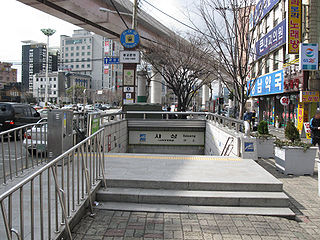
Sasang Station is a station on the Busan Metro Line 2 and BGLRT Line located in Gwaebeop-dong,Sasang District,Busan. The subname in parentheses of Busan Metro is Seobu Bus Terminal.

The Donghae Line is a railway line connecting Busanjin station to Yeongdeok in South Korea. The literal meaning of its name,the "East Sea Line," reflects its position along the nation's East coast. It merged with the Donghae Nambu Line on December 30,2016,and will merge with the Donghae Bukbu Line.
Sasang–Hadan Line is a prospective light metro line in Busan,South Korea. The first phase will connect Sasang Station to Hadan Station. It is highly likely to open under the name "Line 5".
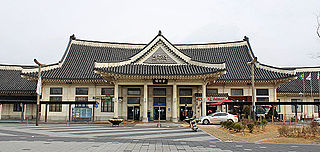
Jeonju Station is a railway station of Jeolla Line,located in Deokjin-gu,Jeonju,South Korea. KTX,ITX-Saemaeul,Mugunghwa-ho,S-Train stops at this station. Jeonju Station's feature is station built as Hanok style.
Sangpyeong station is a closed train station in Okgu Line,North Jeolla,South Korea.
Gwanmun-daero is the city expressway located in Busan,South Korea. The road opened on December 10,2001 connecting Busan Harbor Part 5 ~ Sujeong Tunnel ~ Gaya Viaduct ~ Busanjin-gu Danggam-dong ~ Baekyang Tunnel ~ Mora Overpass ~ Samrak IC.

Moryang station is a railway station of the Donghae Line and Jungang Line in Gyeongju,North Gyeongsang Province,South Korea.
















